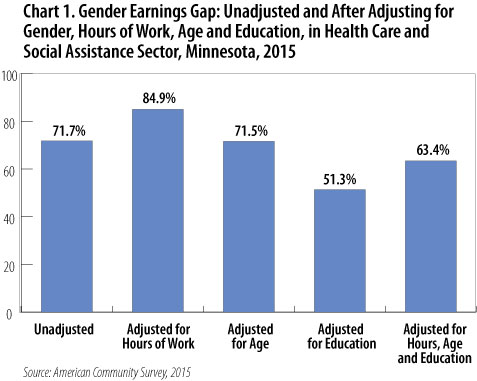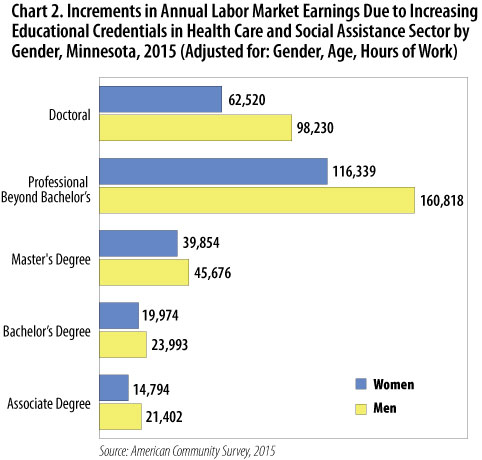
by Sanjukta Chaudhuri
December 2017
For a variety of reasons, including gender bias, women earn 28.3 percent less than men in health care and social assistance jobs.
Women earn 15 percent less than men in Minnesota, according to data from the 2015 American Community Survey (ACS). Industry breakdowns reveal that women's median earnings are lower than men's in all 20 aggregated industries in Minnesota. Women earn less than men even when comparing women and men who work in the same industry for the same number of hours.
This article examines health care and social assistance jobs in Minnesota, an industry sector where women far outnumber men and where we might expect little or no gender pay gap. In fact, men still earn more than women even in these predominately female workplaces.
Both uncontrolled annual earnings of women and men are compared, as well as earnings after controlling for age, education and hours of work. Gender earnings gaps by detailed industry and occupations within health care and social assistance also are examined.
With a gross domestic product (GDP) of $30 billion in 2015, health care and social assistance accounted for 9.2 percent of Minnesota's GDP, making this the fifth-largest industry sector in the state by this measure, according to the Bureau of Economic Analysis.
Health care and social assistance is the largest employer in Minnesota. In 2015, this sector alone employed more than 462,778 people, which accounted for 17 percent of Minnesota's employed workers, according to the Quarterly Census of Employment and Wages. DEED's long-term projections indicate the sector is expected to grow by 17.4 percent between 2014 and 2024, making it the fastest-growing industry in Minnesota.
More than one-quarter of all full-time working women in Minnesota are employed in health care and social assistance, making it the leading employer of women. Over 78 percent of full-time workers in the sector are women. All of its 15 detailed industries are dominated by women, and the share of women is as high as 94.1 percent in child day care services.
In 2015, 65 percent of workers employed in health care and social assistance usually worked 35 hours or more per week and had median annual earnings of $40,000. The unemployment rate for workers 16 or older in this sector was 1.9 percent in 2015. Educational attainment of full-time workers in the sector shows the following breakdown: associate degree (16.5 percent), bachelor's degree (26 percent), master's degree (8.7 percent), professional degree beyond bachelor's (7.5 percent) and doctoral degree (3.3 percent).
Among full-time workers, median annual earnings, not controlled for demographic factors, were $52,000 for men and $37,300 for women, for an earnings ratio of 71.7 percent. Put simply, women make 28.3 percent less than men in this sector.
One factor in women's lower earnings is that they tend to work fewer hours than men. In health care and social assistance, the median full-time work schedule is 40 hours per week for both women and men, while the average hours of work is 44.8 hours for men and 42.3 hours for women.
Since more hours of work can be expected to increase earnings and since men have more hours of work than women, it makes sense then to compare earnings after controlling for hours of work. The median gender earnings ratio after controlling for hours of work improves from 71.7 percent to 85 percent, with the gender earnings gap dropping from 28.3 percent to 15 percent (see Chart 1). This suggests that about one-half of the gender earnings gap between men and women is due to fewer hours of work by women.

Educational attainment is another characteristic that may drive earnings gaps, with more education usually commanding higher earnings. If men have more education than women in this sector, then the uncontrolled earnings gap of 28.3 percent should go down after controlling for education.
Men do have more education than women in health care and social assistance: 58.6 percent of women and 73 percent of men have at least an associate degree; 4.1 percent of women and 18.6 percent of men have a professional degree beyond a bachelor's degree; and 2.3 percent of women and 6.2 percent of men have a doctoral degree.
However, after controlling for five levels of education ("no college degree" is the base category against which the other award levels are compared), the gender earnings ratio, instead of improving, actually worsens to 51.3 percent.
This suggests that women and men employed in health care and social assistance are rewarded differently for the same educational attainment. Chart 2 shows the sectoral average increases in wage and salary income by award level, after controlling for hours of work and age. At all levels of education, men receive a higher salary premium than women, with the gap increasing as the degree level increases.

To summarize, although women have less education than men in this sector, the gender earnings ratio, after controlling for education, actually worsens. This suggests that at the same education level, women are paid less than men. This gendered differential in earnings at the same level of education is potentially a major contributor to the overall earnings gap.
Finally, using both hours and education as controls, with age as a proxy variable for work experience, the gender earnings ratio stands at 63.4 percent (see Chart 1). This suggests that hours of work and educational attainment are key economic variables associated with the overall gender earnings ratio in this sector.
One commonly cited cause of the gender earnings gap is that women and men might work in industries that pay differently. If women are concentrated in lower-paying industries and men in higher-paying ones, this could be a significant factor driving the overall earnings gap. In Table 1, we can see in the second and third columns women are more concentrated in lower-paying industries, including child day care services and skilled nursing facilities, while men are more concentrated in higher-paying industries, including hospitals and offices of physicians.
Table 1. Distribution, Earnings, and Earnings Gaps by Detailed Industries in Health Care and Social Assistance Sector, Minnesota, 2015
| Sub-sectors in Health Care and Social Assistance | Distribution of Men (%) | Distribution of Women (%) | Share of Women (%) | Median Annual Earnings Women | Median Annual Earnings Men | Male to Female Wage Gap (%) |
|---|---|---|---|---|---|---|
| Child Day Care Services | 1 | 9 | 95.4 | $15,000 | $9,000 | -66.7 |
| Vocational Rehabilitation Services | 2 | 2 | 74.5 | $25,000 | $46,700 | 46.5 |
| Residential Care Facilities, except Skilled Nursing Facilities | 7 | 8 | 78.0 | $28,000 | $31,500 | 11.1 |
| Home Health Care Services | 3 | 5 | 84.0 | $29,200 | $32,000 | 8.8 |
| Individual and Family Services | 8 | 10 | 79.5 | $30,000 | $38,000 | 21.1 |
| Nursing Care Facilities; Skilled Nursing Facilities | 5 | 10 | 86.9 | $33,500 | $25,600 | -30.9 |
| Community Food and Housing, and Emergency Services | 1 | 1 | 75.6 | $35,000 | $60,000 | 41.7 |
| Offices of Other Health Practitioners | 1 | 1 | 75.2 | $40,000 | $130,000 | 69.2 |
| Offices of Physicians | 6 | 4 | 68.6 | $40,000 | $181,000 | 77.9 |
| Other Health Care Services | 9 | 3 | 54.5 | $40,000 | $61,000 | 34.4 |
| Offices of Dentists | 3 | 3 | 75.8 | $42,000 | $120,000 | 65.0 |
| Outpatient Care Centers | 14 | 12 | 73.4 | $44,500 | $50,000 | 11.0 |
| Hospitals | 38 | 32 | 72.9 | $50,000 | $62,000 | 19.4 |
| Office of Chiropractors | 1 | 0 | 58.2 | $55,000 | $84,000 | 34.5 |
| Offices of Optometrists | 1 | 0 | 60.5 | $56,000 | $100,000 | 44.0 |
| Total | 99 | 91 | 76.2 | $37,300 | $52,000 | 28.3 |
| Source: American Community Survey, 2015 | ||||||
One can assess the impact of dissimilarity in the distribution of women and men across detailed industries on the overall earnings gap through a hypothetical exercise of re-distributing women between sectors until their distribution is identical to that of men. As an example, if some women were moved from lower-paying child day care services into higher-paying hospitals, then their earnings would increase from $15,000 to $50,000. Similar shifts between detailed industries to achieve parity in distribution could potentially close a substantial proportion of the overall earnings gap.
A sharp difference in median earnings exists between genders within subsectors, suggesting that this is an important factor driving the overall gender earnings gap. Depending on the detailed industry, the median earnings differ widely for women and men, with the gender gap ranging from 22.1 percent in offices of physicians to 166.7 percent in child day care services.
Generally, men massively out-earn women in the highest-paying detailed industries, while women out-earn men in the lowest-paying detailed industries.
Men out-earn women in offices of physicians, other health practitioners, dentists, vocational rehabilitation services, optometrists, chiropractors, and community food, housing and emergency services. Men also out-earn women in individual and family services, hospitals, residential care facilities, outpatient care centers and home health care services.
Women, meanwhile, out-earn men by wide margins in skilled nursing facilities and child day care services. Both these sectors, however, have some of the lowest annual earnings.
There is some evidence that dissimilarity in occupational distribution can also help to explain the gender earnings gap (see columns 2 and 3 of Table 2). Earnings are lower in occupational groups in which women are concentrated, including health care support ($30,000), office and administrative support ($35,400) and personal care and service ($20,000).
Men, on the other hand, tend to be concentrated in health care practitioners and technical occupations, where the median salary is much higher at $89,000.
Within-occupation wage and salary figures are starkly inequitable, with women earning less than men in all but six occupations (see Table 2). The gender ratio ranges from a low of 67.4 percent (earnings gap of 32.6 percent) in health care practitioners and technical occupations to 84.1 percent (earnings gap of 15.9 percent) in office and administrative support. Women out-earn men in six occupational groups, including health care support and community and social services. Less than a quarter of women, however, are employed in the occupational groups where they out-earn men.
Table 2. Distribution, Earnings, and Earnings Gaps by Detailed Occupation in Health Care and Social Assistance Sector, Minnesota, 2015
| Occupations Held in Health Care and Social Assistance Sector | Distribution of Men (%) | Distribution of Women (%) | Share of Women | Median Annual Earnings Women | Median Annual Earnings Men | Male to Female Wage Gap (%) |
|---|---|---|---|---|---|---|
| Sales and Related | 0 | 0.1 | 89.7% | $240,000 | na | na |
| Legal | 0.1 | 0.1 | 74.4% | $200,000 | $84,000 | -138.1 |
| Arts, Design, Entertainment, Sports and Media | 0.3 | 0.4 | 82.4% | $60,000 | $30,000 | -100.0 |
| Food Preparation and Serving Related | 1.5 | 1.3 | 73.1% | $24,000 | $14,000 | -71.4 |
| Community and Social Services | 10.6 | 7 | 67.8% | $40,000 | $35,000 | -14.3 |
| Transportation and Material Moving | 1.6 | 0.1 | 16.9% | $21,000 | $19,000 | -10.5 |
| Healthcare Support | 5.4 | 14.3 | 89.5% | $30,000 | $29,400 | -2.0 |
| Office and Administrative Support | 3.3 | 13.2 | 92.8% | $35,000 | $41,600 | 15.9 |
| Life, Physical and Social Science | 1.9 | 2.2 | 78.6% | $50,000 | $60,000 | 16.7 |
| Business and Financial Operations | 2.3 | 2.9 | 79.8% | $48,000 | $60,000 | 20.0 |
| Personal Care and Service | 4.1 | 12.7 | 90.8% | $20,000 | $25,000 | 20.0 |
| Education, Training and Library | 0.9 | 3.3 | 91.9% | $22,200 | $28,000 | 20.7 |
| Computer and Mathematical | 3.9 | 1.2 | 48.9% | $55,000 | $74,000 | 25.7 |
| Protective Service | 0.8 | 0.2 | 47.9% | $35,000 | $48,000 | 27.1 |
| Healthcare Practitioners and Technical | 45.6 | 32.9 | 69.9% | $60,000 | $89,000 | 32.6 |
| Management | 9.1 | 5.9 | 67.5% | $50,000 | $75,000 | 33.3 |
| Building and Grounds Cleaning and Maintenance | 5.3 | 1.1 | 39.8% | $24,000 | $36,500 | 34.2 |
| Architecture and Engineering | 0.2 | 0.1 | 49.2% | $78,000 | $120,000 | 35.0 |
| Construction and Extraction | 0.2 | 0 | 41.7% | $31,000 | $49,000 | 36.7 |
| Production | 1.7 | 0.9 | 63.5% | $20,000 | $35,000 | 42.9 |
| Installation, Maintenance and Repair | 1.1 | 0.1 | 15.1% | $18,500 | $61,000 | 69.7 |
| Source: American Community Survey, 2015 | ||||||
To further examine this within-occupation earnings gap, consider the occupational group health care practitioners and technical. Thirty-three percent of women and 46 percent of men in the health care and social assistance sector work in jobs in this occupational group. Men out-earn women by 32.6 percent in this occupational group. Within detailed occupations in this group, the most popular choice for men is physicians and surgeons (35 percent), while only 7.3 percent of women opt for this occupation. The most popular choice for women, on the other hand, is nursing, with 53.3 percent of women choosing a nursing occupation but less than a quarter of men.
Occupational choices matter when it comes to earnings. Almost 50 percent of men are in health care practitioner and technical occupations that pay a median salary of $100,000 or more. Only 14 percent of women choose these high-paying occupations. Compared with these high-paying occupations, the nursing occupations that are far more popular among women tend to pay lower median earnings. For example, median annual earnings are $65,000 for registered nurses and $31,200 for licensed practical and licensed vocational nurses.
Women, however, pay a double penalty in terms of occupational choice. Even within the high-paying physicians and surgeons occupation, women earn a median annual salary of $175,000, while men earn $240,000.
This article analyzed economic variables to explain a 28.3 percent gender earnings gap in health care and social assistance, the largest and most female-dominated sector in Minnesota. Hours of work, age, education, detailed industry and occupational distribution, and detailed industry and occupational patterns of gender earnings gaps were examined. Findings suggest that all of these variables have significant association with the overall earnings gap.
A particularly important finding is that a significant gendered differential in salary premium due to education is a major cause of the overall earnings gap in this sector. This essentially means that for the same educational attainment, women are paid less than men, after controlling for other factors such as hours of work. In fact, the gap in salary premium is highest for women with the highest level of education. This finding, which suggests unconscious gender bias in this sector, deserves top priority for further research.
Further investigation of the gendered dissimilarities by and within occupation is also needed. A more formal approach would use the Duncan dissimilarity index and break down the gender earnings gap between the part that is due to across-occupational dissimilarity and the part that is due to within-occupation earnings differential. Delving into the detailed occupation level will also surely reveal valuable insights into the gender earnings gap.